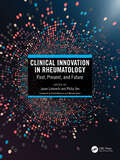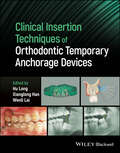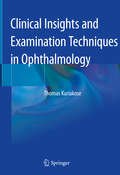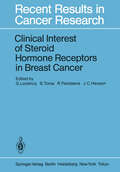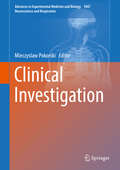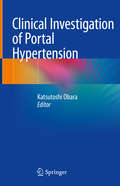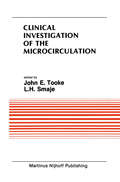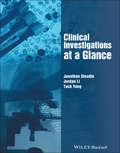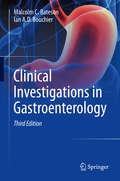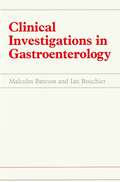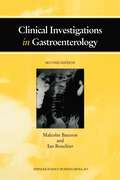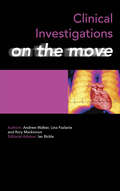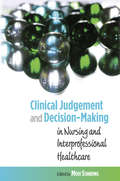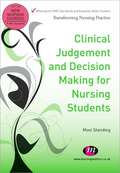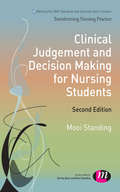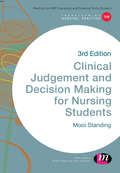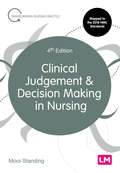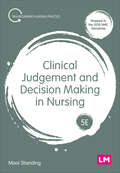- Table View
- List View
Clinical Innovation in Rheumatology: Past, Present, and Future
by Jason Liebowitz Philip SeoTremendous advances have been made in the field of rheumatology, profoundly changing our understanding of many rheumatologic conditions and creating a new frontier for effective treatments. This book explains the most significant advances in research and care and speculates as to what will be the future of rheumatology over the next several decades, including challenges and lessons learned from past experiences in the field. It highlights landmark research articles and scientific discoveries, discusses how big data, personalized medicine, new biomarkers for disease, and other technological revolutions will shape the future, making it a must-have resource for physicians from all regions of the world. Key Features• Includes concise yet thorough description of the landmark studies and scientific breakthroughs coupled with easy-to-follow organizational structure of chapters that are accessible to readers at different levels of training.• Brings together world-leading experts to provide a fresh perspective to trainees such as residents and fellows-in-training, as well as more senior clinicians and researchers across the field of rheumatology and in specialties such as cardiology, dermatology, pulmonology, nephrology, and neurology, all of whom care for patients with rheumatologic conditions.• Allows the authors to imagine and speculate about the evolution of the field of rheumatology in the coming decades. Examples of such speculative possibilities include use of synovial biopsy to predict response to treatment in rheumatoid arthritis, replacement of renal biopsy with urinary proteomics in diagnosing and classifying lupus nephritis, use of new therapeutics to obviate the need for steroids in the treatment of ANCA-associated vasculitis, and the use of machine learning to evaluate subtle changes in imaging for management of inflammatory arthritis.
Clinical Insertion Techniques of Orthodontic Temporary Anchorage Devices
by Hu LongClinical Insertion Techniques of Orthodontic Temporary Anchorage Devices Learn to design and insert Temporary Anchorage Devices with this groundbreaking guide. Clinical Insertion Techniques of Orthodontic Temporary Anchorage Devices is the first comprehensive guide to the clinical insertion techniques for temporary anchorage devices (TADs) and the clinical applications of TADs according to different anatomic regions. It provides detailed clinical insertion instructions and applications, as well as guidance on choosing an optimal insertion site, detailed insertion techniques, and potential complications and their solutions. Divided into five parts, the first covers general considerations, the second explores the techniques at different insertion sites, the third section delves into the clinical applications of miniplates, the fourth delivers the guided insertion of mini-implants, and the fifth section outlines the adverse effects of insertions. The result is a book which brings TADs into orthodontic practice in a rigorous and accessible way. Clinical Insertion Techniques of Orthodontic Temporary Anchorage Devices readers will also find: Around 800 photographs and illustrations demonstrating different insertion techniques and clinical applications Detailed coverage of all maxillary and mandibular regions as potential insertion sites Design and application guidelines for insertion guides Clinical Insertion Techniques of Orthodontic Temporary Anchorage Devices is indispensable for orthodontic clinicians looking for a reference on this area of orthodontics.
Clinical Insertion Techniques of Orthodontic Temporary Anchorage Devices
by Hu Long Xianglong Han Wenli LaiClinical Insertion Techniques of Orthodontic Temporary Anchorage Devices Learn to design and insert Temporary Anchorage Devices with this groundbreaking guide. Clinical Insertion Techniques of Orthodontic Temporary Anchorage Devices is the first comprehensive guide to the clinical insertion techniques for temporary anchorage devices (TADs) and the clinical applications of TADs according to different anatomic regions. It provides detailed clinical insertion instructions and applications, as well as guidance on choosing an optimal insertion site, detailed insertion techniques, and potential complications and their solutions. Divided into five parts, the first covers general considerations, the second explores the techniques at different insertion sites, the third section delves into the clinical applications of miniplates, the fourth delivers the guided insertion of mini-implants, and the fifth section outlines the adverse effects of insertions. The result is a book which brings TADs into orthodontic practice in a rigorous and accessible way. Clinical Insertion Techniques of Orthodontic Temporary Anchorage Devices readers will also find: Around 800 photographs and illustrations demonstrating different insertion techniques and clinical applications Detailed coverage of all maxillary and mandibular regions as potential insertion sites Design and application guidelines for insertion guides Clinical Insertion Techniques of Orthodontic Temporary Anchorage Devices is indispensable for orthodontic clinicians looking for a reference on this area of orthodontics.
Clinical Insights and Examination Techniques in Ophthalmology
by Thomas KuriakoseThis book elucidates the principles of sound clinical examination in ophthalmology. Based on the author’s extensive teaching experience, it makes the case for arriving at a diagnosis through detailed clinical examinations, including history taking, knowledge of clinical epidemiology, and using only the most relevant clinical tests. Starting with basic chapters on relevant statistics and clinical epidemiology, the book covers history-taking, visual function assessment, slit lamp examination, and examinations of each important field (e.g. the lids, orbit, cornea, iris and pupil, glaucoma patients, sclera, lens, posterior segment, pediatric patient and neuro-ophthalmology) in separate chapters. Full of practical tips on examining patients at the clinic, the book also describes the rationale behind each clinical test and its interpretation. It is also hoped that teachers who come across this book will evaluate students on the basis of these relevant clinical examinations rather than quizzing them on esoteric clinical tests that are not routinely used and are of little clinical value. This book is intended to help all ophthalmologists, beginners and veterans alike, improve their clinical examination thinking and skills.
Clinical Interest of Steroid Hormone Receptors in Breast Cancer (Recent Results in Cancer Research #91)
by G. Leclercq, S. Toma, R. Paridaens and J. C. HeusonSeveral papers dealing with the clinical relevance of steroid hormone receptors in breast cancer have already been published. However, no publication has overviewed studies currently being conducted in Europe, nor is there a register of the european centers performing receptor assays. It has been our purpose to fill these gaps. A large majority of authors who we contacted kindly agreed to con tribute to our book. Papers were grouped into six main parts according to their contents. The abundance of clinical data relevant to receptor assays led us to add critical summaries to help the reader to form his own opinions on the subject. We would like to thank Drs. R. J. B. King, G. Contesso, L. Santi, and E. Engelsman, who helped us in this regard. We hope that this book will enable the reader to become acquainted with the present state of European steroid hormone receptor studies devoted to breast cancer treatment. We also hope that it will promote cooperation between European oncologists involved in this field of research.
Clinical Investigation (Advances in Experimental Medicine and Biology #1047)
by Mieczyslaw PokorskiClinical investigation plays an essential role in the differential diagnosis, biomarker development, and therapy and cure of diseases. The book presents a bench-to-bed approach, with broad empirical coverage by experienced practitioners. The articles include topics like cytokine receptors in lung cancer, conduciveness of oxidative stress to carcinogenesis, safety and effectiveness of surgical correction of deformed chest, diagnostic and treatment regimens in inflammation-ridden obstructive lung conditions, alterations in growth hormone secretion leading to disorders of growth and metabolism, microbiota transplantation in pediatric patients, and the promising markers of renal epithelial injury. Yet another issue concerns the restructuring of chronic pain management by establishing the community-based specialized pain clinics. The book aims to disseminate and deliberate on the latest interdisciplinary medical knowledge to enhance clinical outcomes. Being a blend of clinical investigation and practice the book is addressed to physicians, scientists, and allied health care professionals.
Clinical Investigation of Portal Hypertension
by Katsutoshi ObaraThis book thoroughly covers various diseases induced by portal hypertension, and introduces novel information for the treatment of patients. Individual chapters address the pathophysiology, diagnosis and treatment options available for the complications induced by portal hypertension. The book fosters practical understanding and provides more evidence-based treatment options in order to improve physicians’ ability to select optimal treatment methods for their patients. Further, it offers readers the latest information concerning developments of the disease such as esophaogastric varices, ectopic varices, portal thrombosis, refractory ascites and hepatic encephalopathy. Clinical Science of Portal Hypertensions is an indispensible resource for both beginning and experienced gastroenterological physicians, endoscopists, liver physicians, radiologists, gastroenterological surgeons, liver surgeons, etc. who treat patients with portal hypertension on a clinical or research basis.
Clinical Investigation of the Microcirculation: Proceedings of the Meeting on Clinical Investigation of the Microcirculation held at London, England September, 1985 (Developments in Cardiovascular Medicine #59)
by L. H. Smaje John E. TookeIn 1628 William Harvey published his discovery of the existence of the microcirculation which he deduced from careful anatomical and physiological study. Thirty-three years later, Malpighi confirmed the presence of capillaries through direct microscopical observation. Subsequent scientific advance has been slow, and in view of the fact that microvascular in the genesis and expression of many pathophysiology may be implicated diseases, our know ledge of human microvascular function is surprisingly limited. This ignorance attests to the difficulty of studying something that is both minute and inaccessible without disturbing the quantity that is being measured. In the last fifteen years, however, direct techniques have been developed for studying human microvascular pressure, flow and permeability. These methods have provided new insights into human microvascular function in health and disease. At the same time there has been a steady growth of new indirect techniques based on a w ide range of physical principles that reflect some or other aspect of microvascular function.
Clinical Investigations at a Glance (At a Glance)
by Jonathan Gleadle Jordan Li Tuck YongClinical Investigations at a Glance provides an up-to-date, evidence-based overview of diagnostic investigations, looking at their choice, importance and interpretation for commonly presenting symptoms and conditions.Designed to help develop the evidence-based use of investigations and interpret results properly, the book provides a unique perspective on many critical issues in medical testing, with the aim of improving diagnostic accuracy and reducing unnecessary tests or harm.Clinical Investigations at a Glance is structured in three parts: an overview of tests; common presentations (such as chest pain, nausea and vomiting, weight loss and anaemia,); and conditions organized by body system, such as cardiovascular disease, respiratory disease and nephrology. Key features include: • How to interpret investigations, using high quality illustrations to compare ‘normal’ and ‘diseased’ results• Evidence-based, including references • How to select the most appropriate investigation, the accuracy of tests and how to manage incidental findings
Clinical Investigations at a Glance (At a Glance)
by Jonathan Gleadle Jordan Li Tuck YongClinical Investigations at a Glance provides an up-to-date, evidence-based overview of diagnostic investigations, looking at their choice, importance and interpretation for commonly presenting symptoms and conditions.Designed to help develop the evidence-based use of investigations and interpret results properly, the book provides a unique perspective on many critical issues in medical testing, with the aim of improving diagnostic accuracy and reducing unnecessary tests or harm.Clinical Investigations at a Glance is structured in three parts: an overview of tests; common presentations (such as chest pain, nausea and vomiting, weight loss and anaemia,); and conditions organized by body system, such as cardiovascular disease, respiratory disease and nephrology. Key features include: • How to interpret investigations, using high quality illustrations to compare ‘normal’ and ‘diseased’ results• Evidence-based, including references • How to select the most appropriate investigation, the accuracy of tests and how to manage incidental findings
Clinical Investigations in Gastroenterology
by Malcolm C. Bateson Ian A.D. BouchierThe new edition of this book provides a comprehensive review of the basic tests available in gastroenterology. Chapters examine widely-used modern techniques such as ultrasonography for Crohn’s disease, capsule endoscopy, elastography and video proctosigmoidoscopy among others. Fully updated to reflect the recent advances in the field in the last 20 years, this volume evaluates investigations for their current clinical usefulness in the management of patients. The reader will benefit from a critical analysis describing those older tests which have proved their worth alongside the newer procedures which have been introduced. Emphasis is placed on those techniques of which the authors have personal experience. The book is designed for trainees and clinicians without special expertise in gastroenterology, as well as being a shelf manual for the gastroenterologist and the staff of gastroenterology investigation units.
Clinical Investigations in Gastroenterology
by M.C. Bateson I. BouchierThis book is a completely up-to-date review of the basic tests available in gastroenterology. It is based on a detailed critical analysis of recently described procedures and the review of more traditional methods; each is as signed its correct place in the modern management of patients. Emphasis is placed on those techniques with which the authors have practical experience. The most useful investigations are indicated in the table of contents by heavy type. Comprehensive references are included to provide information about the selection, performance and interpretation of tests. The book is designed for trainees and clinicians without special expertise in gastroenterology, as well as being a shelf manual for the gastroenterologist and the staff of gastrointestinal investigation units. Special thanks are due to the nursing staff of the Day Ward, Bishop Auck land General Hospital; Mr P. Grencis, Medical Photographer; Dr S. Desai, Radiologist; and Amanda Gallagher who typed the manuscript. Malcolm C. Bateson Ian A. D. Bouchier 1988 xu CHAPTER 1 Intubation The passage of various forms of nasogastric, duodenal and intestinal tubes is basic to many of the diagnostic procedures performed in the gastrointestinal system. Method Whenever possible the patient's fullest co-operation should be obtained. If the patient is taking any drugs which might influence the test to be under taken these should be discontinued.
Clinical Investigations in Gastroenterology
by M.C. Bateson I. BouchierThis book is a review of the basic tests available in gastroenterology. Emphasis is placed on these techniques of which the authors have personal experiece. The philosophy has been to evaluate investigations for their current clinical usefulness in the management of patients. A critical analysis has been made to describe those older tests which have proved their worth alongside the newer procedures which have been introduced. Just as some recent additions have rapidly gained importance, some familiar tests have lost significance because of medical progress. Testing for Helicobacter pylori has more use than acid secretory studies in the age when antibiotics have displaced the surgeon in the management of chronic peptic ulcer disease. The book is designed for trainees and clinicians without special expertise in gastroenterology, as well as being a shelf manual for the gastroenterologist and the staff of gastroenterology investigation units. Special thanks are due to the nurses on the Bishop Auckland Gastroenterology Unit, and to Amanda Gallagher who typed the manuscript. Malcolm C. Bateson Ian A.D. Bouchier 1996 Xl CHAPTER 1 H elicobacter pylori INTRODUCTION The discovery of the presence of this organism in many human stomachs and its association with disease has revolutionized our approach to peptic ulcer. Detection of H. pylori infection of the gastric mucosa and proof of its absence after eradication therapy have become pivotal in patient management. EPIDEMIOLOGY H. pylori infection is strongly associated with age and inversely with wealth.
Clinical Investigations on the Move
by Andrew Walker Lina Fazlanie Rory MackinnonThe Medicine on the Move series provides fully flexible access to subjects across the curriculum in a unique combination of print and mobile formats ideal for the busy medical student and junior doctor. No matter what your learning style, whether you are studying a subject for the first time or revisiting it during exam preparation, Medicine on the
Clinical judgement and decision-making (UK Higher Education OUP Humanities & Social Sciences Health & Social Welfare)
by Mooi Standing"Mooi Standing's book provides an excellent application of the principal concepts of Cognitive Continuum Theory; her presentation is clear, accurate and her inferences show that she has a first rate grasp of the implications of the theory, and what it means for the care of patients. Her work should stand as a monument to the application of psychological theory to nursing care."Professor Emeritus Kenneth R. Hammond, University of Colorado, USASound clinical judgement and decision-making is vital to delivery of high quality, patient-centred, nursing and interprofessional healthcare. This book integrates the theory and practice of decision-making to guide and enhance practitioners' understanding and clinical expertise. Mooi Standing presents relevant, contemporary theory and research that relates decision-making to: Professional identity Organization of healthcareDeveloping knowledge and skillsSelecting and applying the most appropriate intervention in clinical practiceReal case studies written by various advanced practitioners demonstrate how to apply theory to practice in reviewing, explaining and continually developing clinical judgement and decision-making skills. A patient's account of care received for a serious illness provides a valuable patient-centred insight. The author's new 'reflexive-pragmatism' model summarizes the key knowledge, skills, values and processes of clinical judgement and decision-making, for readers to apply in reviewing and enhancing their own clinical practice. Extensive reflective activities and self assessment tools are included throughout the book.Clinical Judgement and Decision-Making is essential reading for qualified nurses, midwives and allied health professionals undertaking CPD modules in judgement and decision-making, evidence-based practice and reflective practice or studying to be advanced practitioners. Contributors: Kate Dewar, Carolyn Jackson, Peter Ellis, Antonio Sama, Roger Goldsmith, Elizabeth Duck, Douglas MacInnes, Susan Plummer, Hesham Hassan, Michael Standing
Clinical Judgement and Decision Making for Nursing Students (1st edition)
by Mooi StandingClinical decision making is now recognised as an indispensable facet of professional nursing care. It is essential that students develop sound decision making skills in order to deal with the challenges they will encounter as registered nurses. This book enables pre-registration nursing students to understand, develop and apply these skills in order to practise safely and effectively. The structure of the book helps the student progress in effective decision making right from the first to final year of their programme. The book links theory to previous students' experiences and clinical scenarios to show how to use these skills in practice. Mooi Standing is an Independent Academic Consultant (UK and International) amp; Accredited NMC Reviewer. She leads on curriculum development, quality review and enhancement of theoretical and practice-based learning in nursing and allied health programmes for Universities across UK and Internationally. She also manages the development of collaborative international partnerships on educational programmes between UK higher education institutions and Asia.
Clinical Judgement and Decision Making for Nursing Students (1st edition) (PDF)
by Mooi StandingClinical decision making is now recognised as an indispensable facet of professional nursing care. It is essential that students develop sound decision making skills in order to deal with the challenges they will encounter as registered nurses. This book enables pre-registration nursing students to understand, develop and apply these skills in order to practise safely and effectively. The structure of the book helps the student progress in effective decision making right from the first to final year of their programme. The book links theory to previous students' experiences and clinical scenarios to show how to use these skills in practice. Mooi Standing is an Independent Academic Consultant (UK and International) amp; Accredited NMC Reviewer. She leads on curriculum development, quality review and enhancement of theoretical and practice-based learning in nursing and allied health programmes for Universities across UK and Internationally. She also manages the development of collaborative international partnerships on educational programmes between UK higher education institutions and Asia.
Clinical Judgement and Decision Making for Nursing Students (2nd edition)
by Dr Mooi StandingClinical decision-making is an indispensable facet of professional nursing care. In order to become a registered nurse it is essential that the student develops sound decision-making skills in order to deal with the challenges ahead. This book enables pre-registration nursing students to understand, develop and apply these skills in order to practise safely and effectively. The structure of the book helps students to progress in effective decision-making right from the first to the final year of their programme. The book links theory to realistic experiences and clinical scenarios to show student nurses how to use these skills in practice. Key features: -provides practical ways designed to help student nurses reach sound and safe decisions -uses active learning features and activities that promote the use of evidence, critical enquiry, reflection and patient-centred care -linked to the latest NMC Standards and Essential Skills Clusters
Clinical Judgement and Decision Making for Nursing Students (2nd edition) (PDF)
by Dr Mooi StandingClinical decision-making is an indispensable facet of professional nursing care. In order to become a registered nurse it is essential that the student develops sound decision-making skills in order to deal with the challenges ahead. This book enables pre-registration nursing students to understand, develop and apply these skills in order to practise safely and effectively. The structure of the book helps students to progress in effective decision-making right from the first to the final year of their programme. The book links theory to realistic experiences and clinical scenarios to show student nurses how to use these skills in practice. Key features: -provides practical ways designed to help student nurses reach sound and safe decisions -uses active learning features and activities that promote the use of evidence, critical enquiry, reflection and patient-centred care -linked to the latest NMC Standards and Essential Skills Clusters
Clinical Judgement and Decision Making in Nursing
by Dr Mooi StandingClinical decision-making is an indispensable facet of professional nursing care. It is essential that students develop sound decision-making skills in order to deal with the challenges they will encounter as registered nurses. This book enables pre-registration nursing students to understand, develop and apply these skills in order to practise safely and effectively. The structure of the book helps the student progress in effective decision-making right from the first to final year of their programme. The book links theory to previous students’ experiences and clinical scenarios to show how to use these skills in practice. Transforming Nursing Practice is a series tailor made for pre-registration student nurses. Each book in the series is: Affordable Mapped to the NMC Standards and Essential Skills Clusters Focused on applying theory to practice Full of active learning features
Clinical Judgement and Decision Making in Nursing (Transforming Nursing Practice Series)
by Mooi StandingClinical decision-making is a fundamental part of professional nursing care and it is essential that students develop sound judgement and decision-making skills in order to deal confidently with the challenges they will encounter as registered nurses. This book enables pre-registration nursing students to understand, develop and apply these skills in order to practise safely and effectively. The book links theory to realistic student experiences and clinical scenarios to show how to use these skills in practice. Key features: · Fully mapped to the new NMC standards of proficiency for registered nurses (2018) · Contains clinical scenarios illustrating decision making in practice · Activities challenge students and build confidence in their judgement and decision making skills.
Clinical Judgement and Decision Making in Nursing (Transforming Nursing Practice Series)
by Mooi StandingClinical decision-making is a fundamental part of professional nursing care and it is essential that students develop sound judgement and decision-making skills in order to deal confidently with the challenges they will encounter as registered nurses. This book enables pre-registration nursing students to understand, develop and apply these skills in order to practise safely and effectively. The book links theory to realistic student experiences and clinical scenarios to show how to use these skills in practice. Key features: · Fully mapped to the new NMC standards of proficiency for registered nurses (2018) · Contains clinical scenarios illustrating decision making in practice · Activities challenge students and build confidence in their judgement and decision making skills.
Clinical Judgement and Decision Making in Nursing (Transforming Nursing Practice Series)
by Mooi StandingClinical decision-making is a fundamental part of professional nursing care and it is essential that students develop sound judgement and decision-making skills in order to deal confidently with the challenges they will encounter as registered nurses. This book enables pre-registration nursing students to understand, develop and apply these skills in order to practise safely and effectively. The book links theory to realistic student experiences and clinical scenarios to show how to use these skills in practice. Key features: · Fully mapped to the new NMC standards of proficiency for registered nurses (2018) · Contains clinical scenarios illustrating decision making in practice · Activities challenge students and build confidence in their judgement and decision making skills.
Clinical Judgement and Decision Making in Nursing (Transforming Nursing Practice Series)
by Mooi StandingClinical judgement and decision making are terms that are frequently used in nursing. But what do they mean and how can they be effectively applied in practice? In straightforward language, this book helps you to develop the necessary skills to make and apply sound clinical decisions. It breaks down the factors involved in decision making and shows you how to use evidence, critical enquiry and reflection to do so with confidence. Key features: - Each chapter is mapped to the 2018 NMC Standards - Thought-provoking case studies and scenarios illustrate decision making in practice - Activities enable you to practise your skills and build confidence in your ability to make effective decisions
Clinical Judgement and Decision Making in Nursing (Transforming Nursing Practice Series)
by Mooi StandingClinical judgement and decision making are terms that are frequently used in nursing. But what do they mean and how can they be effectively applied in practice? In straightforward language, this book helps you to develop the necessary skills to make and apply sound clinical decisions. It breaks down the factors involved in decision making and shows you how to use evidence, critical enquiry and reflection to do so with confidence. Key features: - Each chapter is mapped to the 2018 NMC Standards - Thought-provoking case studies and scenarios illustrate decision making in practice - Activities enable you to practise your skills and build confidence in your ability to make effective decisions
